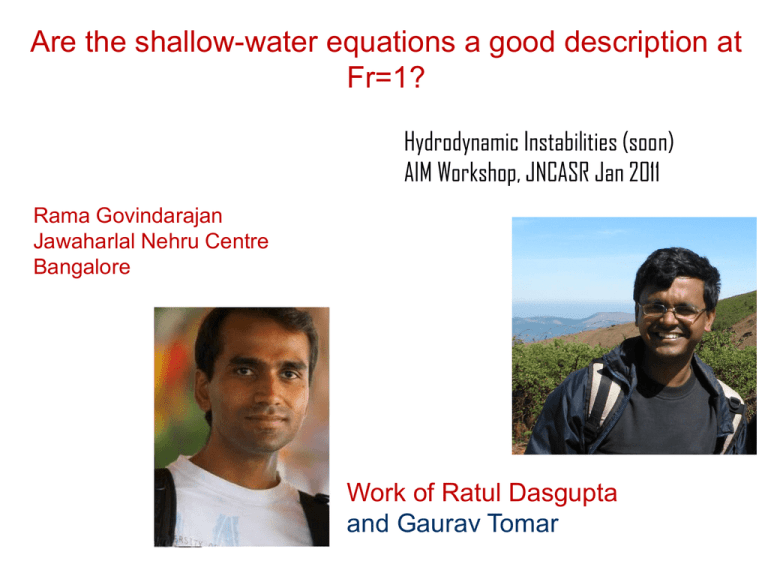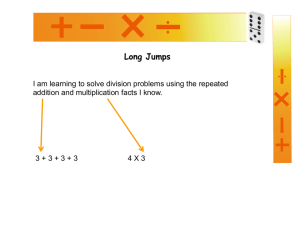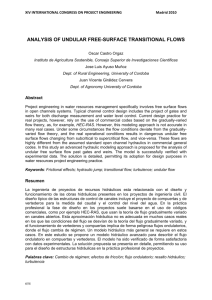2011_JNCASR_Rama
advertisement

Are the shallow-water equations a good description at
Fr=1?
Hydrodynamic Instabilities (soon)
AIM Workshop, JNCASR Jan 2011
Rama Govindarajan
Jawaharlal Nehru Centre
Bangalore
Work of Ratul Dasgupta
and Gaurav Tomar
Shallow-water equations (SWE)
u
t
u u u
2
1
p
g h
h
h' h /
Gradients of dynamic pressure h ' ' h /
2
Inviscid shallow-water equations (SWE)
Pressure: hydrostatic, since long wave
u u
1
p
(u u ) x g
Fr<1
h
dh
Fr >1
dx
u
2
gh C
2
x
uh Q
Fr
2
u
2
gh
Lord Rayleigh, 1914: Across Fr=1
Mass and momentum conserved
Energy cannot be conserved
If energy decreases, height MUST increase
nndb.com
U2,h2
U1,h1
Tomas Bohr and many, 2011 ...
dcwww.camd.dtu
.dk/~tbohr/
The inviscid description
Fr 1
U1
Fr 2
1
gH 1
H2
H1
U2
U2
gH
1
2
U1
The transition from Fr > 1 to Fr < 1 cannot happen smoothly
There has to be a shock at Fr = 1
c
gH 1
Viscous SWE still used at Fr of O(1) and elsewhere
In analytical work and simulations
5
Can give realistic height profiles
Viscous SWE (vertical averaging) closure problem
dh
(u u ) x g
h
dx
u yy
Fr=1
Singha et al. PRE 2005
similarity assumption
parabolic
no jump
x
Better model:
Cubic Pohlhausen profile
u
U ( )
a ( ) b ( ) c ( )
Watanabe et al. 2003, Bonn et al. 2009
2
3
Qf
Planar BLSWE
u 0
(u u ) x g
dh
dx
u yy
Re Q / , Fr Q /( g
f
+
1/ 2
y
h( x)
dx
, d
h ( x ) Re
Dasgupta and RG,
h
3/2
)
Phys. Fluids 2010
1
2
h ' Re
f
Re
f f f f
2
Fr
f ( 0 , ) 0 , f (1, ) 1, f (1, ) 0
In addition f (1, ) 1
EXACT EQUATION: solved as o.d.e.
Reynolds scales out
h and f from same equation
Similarity solutions for Fr >> 1 and Fr << 1
Upstream Watson, Gravityfree (1964)
f h ' Re f 0
2
Downstream parabolic profile
Velocity-profile does not admit a cubic term
Drawback with the Pohlhausen model
Although height profiles good
9
BLSWE
h ' f f f f f
2
I G VS
1
Fr
2
h'
1
Re
f
Velocity profiles
Low Froude P solution
Highly reversed. Very unstable
Planar – Height Profile
Velocity profile and h’:
Functions only of Froude
`Jump’ without downstream b.c.!
Behaviour changes at Fr ~1
Upstream
h ' Re 1 . 814
Circular – No fitting parameter
Near-jump region: SWE not good?
need simulations of full Navier-Stokes
A circular hydraulic jump
Simulations
Tidal bores
Arnside viaduct
http://www
.geograph.org
.uk/photo/3245
81
http://ponce.sds
u.edu/pororoca_
photos.html
http://www.metro.co.uk/news/article.html?in_arti
cle_id=45986&in_page_id=3
The pororoca: up to 4 m
high on the Amazon
Chanson, Euro. J.
Mec B Fluids 2009
Motivation: gravity-free hydraulic
jumps (Phys. Rev. Lett., 2007,
Mathur et al.)
Navier-Stokes simulations – Circular and Planar
GERRIS by Stephane Popinet of NIWA, NewZealand
Planar Geometry
Note: very few
earlier simulations
Circular: Yokoi et al., Ferreira et al. 2002
Elliptic???
Effect of domain size
SWE always too gentle near jump
PHJ - Computations
Non-hydrostatic effects
23
Typical planar
jump
U, Fr < 1
J, Fr ~ 1
P, Fr > 1
N, Fr < 1
The story so far
I - G + D + B + VS + VO = 0
BLSWE: I - G +VS = 0?
Good when Fr > 1.5
Good (with new N solution) when Fr < 0.8
Fr ~1
I ~ G, singular behaviour as in Rayleigh equation
(U c )( ' ' ) U ' ' 0 ?
2
KdV: I - G + D = 0
Singular perturbation problem
I G D
1
Re
h' h /
h ' ' ' ' ....
WKB ansatz
take h’ large
1 / h' / h
Lowest order equation O(1)
Either is O(R-1) or jump is less singular. With latter
Only dispersive terms contribute at the lowest order
{Subset of D} = 0
At order
{Different subset of D + Vo} = 0
No term from SWE at first two orders
Gravity unimportant here!! (Except via asymptotic
matching (many options))
h’ need not always be large
In fact planar always very weak ~ O(1) or bigger!
No reduction of NS
Undular region
Model of Johnson:
Adhoc introduction of a viscous-like
term, I-G+D + V1 = 0. Our model for the undular region
Conclusions
Exact BLSWE works well upstream
multiple solutions downstream, N solution works well
Behaviour change at Fr=1 for ANY film flow
Planar jump weak, undular
Different balance of power in the near-jump region
gravity unimportant
Undular region complicated viscous version of
KdV equation
Always separates, separation causes jump? .....
Analytical: circular jump less likely to separate
Circular jumps of Type 0 and Type II-prime
Standard Type I
Type ``II-prime’’
Type ``0’’
Circular jump FrN=7.5
Increasing Reynolds, weaker jump
Numerical solution: initial momentum flux
matters
Effect of surface tension
Planar jumps – Effect of change of inlet Froude
Wave - breaking
h' Fr i
Steeper jumps with decreasing Fr
As in Avedesian et al. 2000, experiment
Inviscid: as F increases, h2 increases
2
Planar jumps – Effect of Reynolds
12.5
25
Steeper jumps with decreasing Reynolds
47









